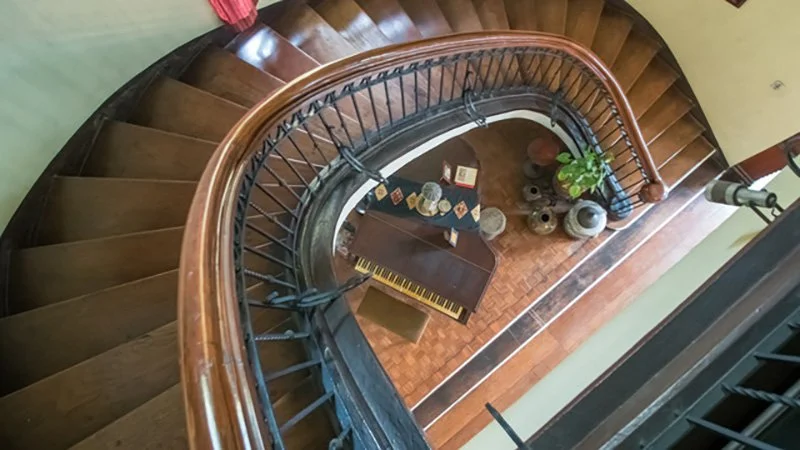MiraNila: Glimpses Into a Gracious Age

The MiraNila Heritage House in Quezon City.
The MiraNila Compound in Quezon City is heritage in both material and non-physical form. The main villa built in 1929 by the Benitez family during the American period, witnessed and survived the Japanese occupation during World War II. Designed by Francisca Tirona Benitez with the help of her cousin Architect Gregorio Paredes, it was built on several hectares of land on hilly terrain in a street lined with stately homes of illustrious Filipino families. The villas and houses had elegant names instead of just a number, then a practice reserved almost solely for estates, manors, and ancestral homes. In the Nineties, the houses gradually gave way to real estate development, bulldozers had cleared most of the mansions which were soon replaced by high- end townhouses and condominiums. MiraNila stayed on and today stands tall through urban sprawl.
The owners of MiraNila, Statesman and Constitutionalist Conrado Benitez and his wife Francisca Tirona, were both distinguished educators; Conrado was the first Filipino dean of the College of Liberal Arts and the founder of the College of Business of Arts both at the University of the Philippines. Together with several colleagues they founded the Philippine Women's University, the first university for women started by Asians.
Francisca had in mind a design that mirrored the elegant and picturesque lines of Italianate architecture. She was inspired by the 19th century structures that had their origins in the Italian Renaissance.
With its harmonious mix of porches and balconies; deep, bracketed eaves; mouldings and a panoply of Salamanca pillars and round arches; the house when constructed, welcomed and entertained family, friends, dignitaries, and ordinary folk. In this house they raised their three children: Tomas, Alfredo, and Helena.

The MilaNila library
MiraNila is practically the only house standing on storied Mariposa Street. Justly so, as it exudes this resonance from the past. The main house has kept a high level of integrity, both externally and internally as it retains its original decorative fixtures, furnishings, and sprawling gardens.
The house was spared from destruction during WWII. Stories abound in this country of Japanese gardeners later revealing themselves as part of the Imperial Japanese Army invading forces. MiraNila was witness to this. In 1941, the family gardener revealed himself as a lieutenant and informed the Benitezes that army officers would soon take over the house, advising all family members and staff to move to PWU on Taft Avenue. Instead, Francisca promptly moved to the bungalow within the property with her twelve-year-old ward, Fely Clemente, from whom this story came. Only when Francisca saw the Japanese removing their shoes before entering the house and the women with them constantly cleaning and polishing the narra floors of MiraNila, did she and Fely leave the compound.*
“With conservation of heritage homes gaining traction in Asia, MiraNila has given itself a new lease on life. ”
There is a comforting sense of nostalgia when Lyca Benitez Brown, Benitez-Tirona MiraNila Foundation Trustee (BTMNF), shares fond memories of growing up in MiraNila, shedding light on family values and social mores of a different age.
“Our grandparents Conrado Benitez and Francisca Tirona Benitez, Tita Helena Z Benitez as well as our parents Tomas C. Benitez and Conchita (Nena) Liboro Benitez inculcated love of country in us but made this real through their civic and charitable actions. We were taught to respect everyone, no matter who they were or what their station was in life. We were taught to behave properly at dinner parties (including conversing with guests - whoever they may be), make visitors feel welcome (including always providing food for their staff, yayas or drivers) and treating household help with kindness and respect. As a young child, I remember memorizing "bugtongs" (riddles) in Filipino and being presented to important guests during parties and challenging them to guess the answers to my riddles. At Christmas we were expected to put up a show - so we presented skits, played musical instruments and performed for our elders - before getting our "aguinaldo" from them. I remember Tita King Kasilag "jamming" with visiting Brazilian musicians and the Bayanihan testing their repertoire before a select audience (which luckily, included us) before their world tours.
We grew up in and around MiraNila – they allowed us to have the run of the house and gardens (including climbing the tower and the trees). I remember spending afternoons listening to my vinyl long playing records in the living room, on a record player that must have been older than me at the time. There was a level of graciousness that naturally came with the house (I never felt that anything was done just for show). Perhaps it was this nurturing environment that gave me a deep appreciation for the Philippines and confidence in our culture - which I hope I was able to share with children through the educational TV program "Batibot" which I produced in the 1980s.
I also remember having weekly Sunday lunches with the family in MiraNila but also formal dinners that we attended there (my father was an Ambassador). My mother (Nena Liboro Benitez) used to host formal dinners for aspiring diplomats in MiraNila where they had to speak extemporaneously on subjects she would write on cards that they found under their plates. Many years later, when I was living in NYC, Amb. Ernesto Pineda told me he attended one of those dinners, as a final exam to get into the foreign service, and was absolutely terrified of my mother. Obviously, he passed because he became the Phils. Permanent Representative to the UN. MiraNila was also the site for meetings of various organizations that the Benitezes were involved in (Associacion de Damas Filipinas (founded by our lola), PWU, The Red Cross, International Rice Research Institute, ILO, Girl Scouts, etc.).
They allowed all the family to entertain in MiraNila so that even our classmates and friends remember attending parties there. I also remember family weddings in MiraNila where the bride had to walk down the staircase as their aisle. At my older sister Bebet's s wedding, she was thrown into our cousin Joly's swimming pool (next door to MiraNila) in her wedding gown! ”

The grand staircase at MiraNila
In order to maintain and preserve the house, its contents and gardens, Helena ( Conrado and Francisca’s only daughter ) donated it to the BTMNF. Established in 2011, its members are 13 nephews and nieces, the children of her brothers Tomas and Alfredo. In 2011, the National Historical Commission granted MiraNila Heritage House status to ensure its artistic integrity and because of its historical and cultural significance.
The main house has been turned into a living Museum giving historical perspective into the social and emotional settings that shaped people’s lives and actions in the past.
“After Tita Helen passed away in 2016, we spent several years cataloguing its contents (including 4,000 books and decorative ware in packing crates stored in the bomb shelter). The museum was opened in 2018 and the events space in 2019 with the help of Blue Leaf (with Bizu as its caterer). During the pandemic, we worked on renovating the Townhouse into a boutique hotel with the help of The Henry Hotel and its designer, Eric Paras who has designed each room to reflect MiraNila, with most of the furniture coming from the old house and various family members.” Benitez adds.
The Townhouse adjacent to MiraNila was built in 1990 by Rosary L. Benitez and Architect Fedor Yap. Designed to allow for its presence in terms of the landscape integrity of the estate, it blends in naturally. The townhouse has now been repurposed to function as a hotel: the seven- room Henry Suites MiraNila combines public functions with private needs creating an intimate ambiance in a storied place. The sprawling lawn and gardens are planted to plants and trees endemic to the Philippines. It’s a lovely setting for many happy celebrations, reunions and family gatherings.
MiraNila, in this century, is all about a new aesthetic offering fresh options that challenge the predictable uniformity of conventional venues for social events. With conservation of heritage homes gaining traction in Asia, MiraNila has given itself a new lease on life. Together with its concept partners -- The Henry Hotel, Bizu Café and Catering Studio, and Blue Leaf Events and Space Management -- it has blended the old and the new for this generation to experience the resonance of the past with all the creature comforts of the present.
A place not short on memories for the public at large, and with strong local historical, and cultural elements, MiraNila stands as proof that the pull of history will always be strong for curious visitors, heritage and culture buffs, wistful enthusiasts, visiting countrymen, and even a bride wanting to have a lovely and distinctive setting for her celebration.
*Excerpt from MiraNila tour script from Petty Benitez Johannot
The MiraNila Heritage House and Library staff are comprised of the founder's former employees.The Benitez-Tirona MiraNila Foundation that Helena formed in 2005 to run the site is today comprised of four trustees: President Purissima (Petty) Benitez-Johannot, Corporate Secretary Lydia Benitez-Brown, Treasurer Alfredo Benitez Reyes, and Trustee Marton Moya Benitez.
The MiraNila Heritage House Library and Pavilion
No. 26 Mariposa St. Brgy Bagong Lipunan, Quezon City
+632 7220243

Glenna Aquino is a Filipino writer and journalist who has written about arts, travel, culture and business for the Philippine Daily Inquirer. She was Asia Pacific Contributing Editor for the Middle East art journal : Art Bahrain. Her writing has been shaped by her various experiences of living in different parts of the world. She now lives in Manila and writes for the online magazine The Diarist.ph.
More from Glenna Aquino






No comments:
Post a Comment